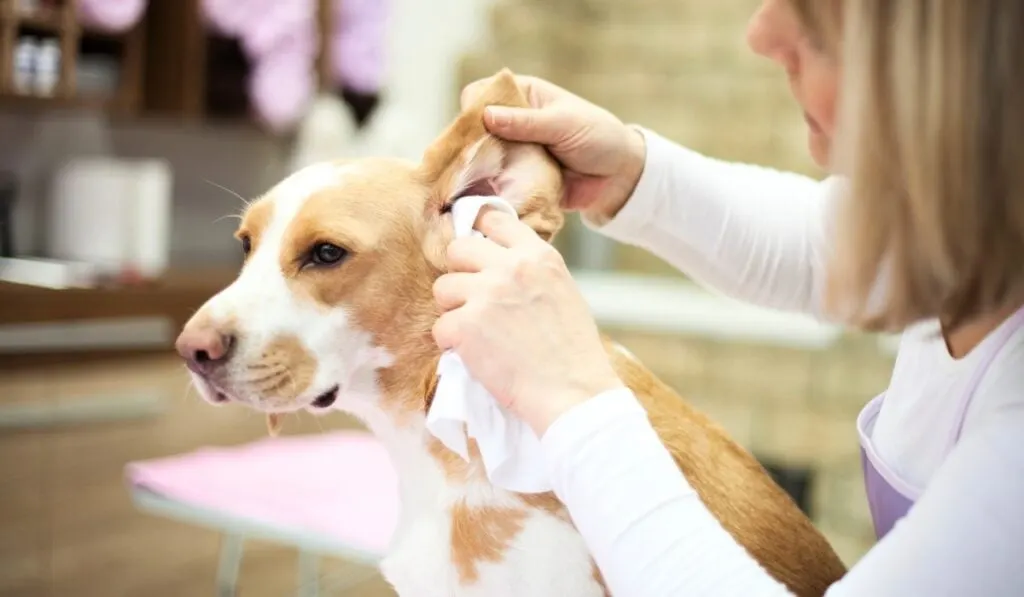Have you ever seen a dog flip their ears inside out and wondered what it means?
Dogs are excellent communicators, and their body language can reveal a lot about their emotions.
Flipping their ears back or forward, or pinning them against their head, is a gesture that can convey a range of emotions.
In this post, we’ll take a closer look at each of these behaviors to better understand what our furry friends are trying to tell us.

10 Reasons why a dog flips their ears back
Let’s run through the most common reasons behind why dogs flip their ears back.
As you can see, in the vast majority of cases, this is not a very serious issue.
However, I’ll explain below that there are a few important things to keep an eye on.
➡️ Cooling down:
One reason why dogs flip their ears inside out is to cool themselves down. Dogs don’t sweat like humans do, so they need to find other ways to regulate their body temperature.
By exposing the inner ear, dogs are able to release heat and cool themselves down.
This is especially important for dogs with thick fur or in hot environments. So, if your dog is panting and flipping their ears inside out, it could be a sign that they are trying to cool down.
➡️ Expressing emotions:
Another possible reason why dogs flip their ears inside out is to express their emotions. Dogs are social creatures that use body language to communicate.
Flipping their ears inside out can be a way for dogs to express excitement, fear, or aggression.
For example, a dog that is feeling excited may flip their ears inside out and wag their tail. On the other hand, a dog that is feeling scared or aggressive may flip their ears inside out as a warning signal to others.
➡️ Feeling itchy:
Dogs can also flip their ears inside out when they are feeling itchy. This is often the case when dogs have ear infections or allergies that cause irritation.
By flipping their ears inside out, dogs can reach the inside of their ears with their paws and scratch the itchy area.
If you notice your dog flipping their ears inside out and scratching them frequently, it may be a sign that they need to see a veterinarian for treatment.
➡️ Attention-seeking:
Sometimes, dogs will flip their ears inside out as a way to get attention from their owners or other dogs.
This can be a playful behavior that is meant to initiate playtime or interaction with others.
If your dog flips their ears inside out and then runs over to you, it may be a sign that they want to play or go for a walk.
➡️ Breed-specific behavior:
Certain dog breeds are more likely to flip their ears inside out than others.
For example, many breeds that were originally bred for hunting, such as Beagles and Basset Hounds, have long ears that they frequently flip inside out.
This behavior is thought to be a trait that was selected for during breeding, as it may have helped dogs to hear better while hunting.
➡️ Relaxation:
In some cases, dogs will flip their ears inside out when they are feeling relaxed or content.
This is often accompanied by other signs of relaxation, such as lying down or wagging their tail.
If your dog flips their ears inside out while they are lying down and seem to be enjoying themselves, it’s likely that they are feeling comfortable and relaxed.
➡️ Discomfort:
On the other hand, flipping their ears inside out can also be a sign that dogs are feeling uncomfortable or in pain.
For example, dogs may flip their ears inside out when they are experiencing ear infections, ear mites, or other ear-related problems.
If your dog is frequently flipping their ears inside out and seems to be in pain or discomfort, it’s important to take them to a veterinarian for evaluation and treatment.
➡️ Trying to hear better:
As mentioned earlier, some breeds of dogs may flip their ears inside out as a way to improve their hearing.
Dogs have a remarkable sense of hearing, and by exposing the inner ear, they may be able to better detect sounds from their environment.
This behavior may be more common in breeds with long, floppy ears, as they are more likely to get in the way of hearing.
➡️ Mimicking pack behavior:
Dogs are social animals that have evolved to live in packs. In a pack, dogs will often mimic each other’s behavior as a way to bond and communicate.
Flipping their ears inside out may be a behavior that some dogs pick up from their pack members.
By mimicking this behavior, dogs may be showing their loyalty to the pack and communicating with their fellow dogs.
➡️ Habitual behavior:
Finally, it’s possible that some dogs flip their ears inside out simply out of habit.
Dogs can develop a wide range of behaviors that may seem strange or unusual to humans, but make perfect sense to them.
If your dog has been flipping their ears inside out for a long time and doesn’t seem to be in any discomfort or distress, it may simply be a quirky behavior that they have developed over time.
Trending: Ingrown Dog Whiskers (what owners need to know)
The Puppy Mag Favorites
👍 Set & Forget Interactive Dog Toy
Perfect for mental stimulation.
😍 The No.1 Low Calorie Dog Treat
Perfect for healthy treat-giving.
Turning their ears inside out and shaking their head
One thing we need to address is when a dog turns their ears inside out but also begins shaking their head at the same time.
This indicates the dog is suffering from an ear infection. Ear infections are a pretty common problem that can occur in dogs of all ages and breeds.
The infection can be caused by bacteria, yeast, or other microorganisms, and can be quite uncomfortable for the dog.
➡️ When a dog has an ear infection, they may experience symptoms such as:
- Scratching or rubbing their ears excessively
- Redness or swelling around the ear canal
- An unpleasant odor coming from the ear
- Discharge or crusty debris in the ear canal
- Pain or sensitivity when touching the ear
Turning their ears inside out and shaking their head are two behaviors that dogs may exhibit when they have an ear infection.
By turning their ears inside out, dogs are trying to relieve the itchiness and discomfort that come with the infection. They may also try to scratch their ears with their paws or rub their ears against objects in the environment.

Should owners worry about this?
Owners generally do not need to worry too much about their dog flipping their ears inside out, as it is often a harmless behavior.
However, if the dog is exhibiting other symptoms, it may be a sign of an underlying problem that requires medical attention.
As discussed earlier, flipping their ears inside out can be a normal behavior for dogs, and can have several different causes.
Some dogs do it to cool down, express emotions, or scratch an itchy ear, while others do it to get attention or mimic pack behavior.
Unless the dog is in any discomfort or distress, there is usually no need for owners to worry about this behavior.
Important: Splayed feet in dogs (what you must know)
What to do if your dog keeps flipping their ears inside out?
Dogs flipping their ears inside out is usually nothing too serious, and it’s a normal part of their behavior. But it’s important to keep an eye out for any accompanying signs that may indicate something is amiss. Here are some conditions to look out for that may require a visit to the vet:
Abnormal behavior:
Dogs may exhibit unusual behavior if there are underlying problems. Keep an eye out for changes in behavior, scratching and shaking the head more than usual, and signs of pain or discomfort.
Deafness:
Dogs rely heavily on their hearing, so if they seem unresponsive to certain sounds or appear not to be paying attention, it could be a sign of hearing loss. If you notice any of these signs, take your dog to the vet for a diagnosis.
Aural Hematoma:
This is a blood clot that forms inside the ear canal, which can be painful for dogs. It’s typically caused by blunt trauma or an object stuck in the ear, but it can also result from tumors, skin diseases, or infection.
Keep an eye out for ear flaps filled with liquid, excessive scratching, tilting of the head, and cauliflower-like growths.
It’s always better to err on the side of caution when it comes to your furry friend’s health. By keeping an eye out for these signs, you can catch any potential problems early and ensure your dog gets the care they need.
Ending thoughts
In conclusion, dogs flipping their ears inside out is a normal behavior and not something to be overly concerned about in most cases.
However, it’s important to be aware of the signs that may indicate an underlying issue, such as aural hematoma, abnormal behavior, or hearing loss.
By paying close attention to your dog’s behavior and seeking veterinary care when necessary, you can ensure your furry friend stays healthy and happy.
